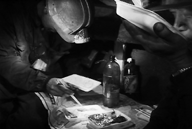Dust Buries Sabuk
Meonji, Sabukeul Mootda KOREA / 2002 / Korean / Color, B&W / Video / 83 min
KOREA / 2002 / Korean / Color, B&W / Video / 83 min
Director, Editing, Narrator, Producer: Lee Mi-young
Photography: Seong Hye-ran, Yoon Jeong-won, Lee Mi-young
Sound: Kim Yi-chan
Music: Misoni, Gong Myeong, Jeong Myeong-hwa
Source: Lee Mi-young
Jin Heung Apt., Da-405 Bu Pyung, Incheon KOREA
Phone: 82-11-9844-3191
E-mail: dustsabuk@empal.com
URL: http://www.dustsabuk.com
South Korea under military rule, 1980. Sabuk mine workers staged an uprising in protest of atrocious working conditions. This was a month before the Kwangju massacre. The miners attacked the trade union head’s house and the police station, and armed police were dispatched to suppress the riots. Three days later, after peace returned, the authorities arrested, detained, and tortured eighty-one people. The director of this film, five years old at the time, decides to speak to all parties involved in this forgotten tragedy. We find that twenty years later, the mining company and government officials have risen to the pinnacle of Korean society, while the former miners still suffer psychologically and physically from the inhumane torture and social discrimination incurred at the time.
[Director’s Statement] The manufacturing of coal, long Korea’s main energy source, was restricted to the northern coalfields during the nation’s period of colonial rule. After the country was divided into North and South following the end of the Korean War in 1953, South Korea was forced to look for alternative sources of energy—an urgent imperative for its program of post-war reconstruction and economic development. As a result, mountainous areas in the south including Sabuk began to be converted into coal mines around 1960, and coal miners were forced to endure severely harsh working conditions. This situation continued until the global economic recession in the late-1970s.
Following the death of its dictator in 1980, South Korea entered a period of political change. In April of this same year, the seething anger on the part of coal miners and ordinary citizens toward the victimization they had experienced under ruthless dictatorial development policy finally found its release.
When I first heard about the 1980 Sabuk uprising, I was shocked that an event of such historical significance had never been properly brought to light. Moreover, the fact that the protesters appeared to nurse bitter disappointment and humiliation about the incident—and not pride—raised many questions for me. Although I repeatedly tried to contact the miners and other protesters by letter, telephone and personal visits, I had little luck. Slowly, it became apparent that this was because their memories of the incident were associated with violence and fear. In other words, they are still unable to emerge from the darkness of the mine pits.
While efforts began in the mid-1990s to reflect on the many incidents from South Korea’s military dictatorship, the Sabuk uprising has remained in historical obscurity. Dust Buries Sabuk attempts to undo the marginalization and severing of the Sabuk coal miners from mainstream history, and focuses on the historical traces left behind by the people of that time period, as well as our own generation who carry on their legacy today.
 Lee Mi-young
Lee Mi-young
Born in 1975. Graduated from Korea University in 1998. Studied German literature. Filmography: Home of Dust (1999) and History of Coal Mine, Sabuk-Kohan (2001). In the winter of her fourth year at university, enduring her first heartbreak and a blizzard, she packed her bags and headed for Sabuk. There, she found a desolation that felt very much like her own. The Sabuk she visited in 1997 had already seen the closing of many of its mines, now obscured by snow; the existence of the mine workers was also being buried in much the same way. It was then that she began making this documentary on Sabuk. This film received awards at festivals including the Seoul Human Rights Film Festival. |
|
• New Asian Currents | Sand and Water | Wellspring | Three-Five People | Homesick | The Circle’s Corner | The Maze of Lanes | Nee Engey—Where Are You | NEW (IMPROVED) DELHI—Director’s Cut | A Night of Prophecy | 150 Seconds Ago | The Ballad of Life | Noah’s Ark | The Old Man of Hara | Dandelion | Hibakusha—At the End of the World | 3rd Vol.2—2 Light House | And Thereafter | Dust Buries Sabuk | Family Project: House of a Father | Edit | Gina Kim’s Video Diary | Ordo | Her and Him Van Leo | The Big Durian | Perpetual Motion | Debris | Hard Good Life | Nail | The Rhythm in Wulu Village | A Short Journey • Jurors | Kim Dong-won | Kawase Naomi • New Asian Currents Special | Part 1 | Part 2 |
